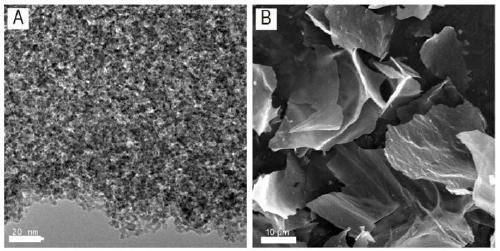Preparation and applications of CeOx/RuO2/MC and CeOx/RuO2 composite nanosheet material
A technology of nanosheets and raw materials, applied in nanotechnology, nanotechnology, nanotechnology, etc. for materials and surface science, can solve the problems of carbon rationality to be considered, and achieve easy large-scale production and good lithium-oxygen battery catalysis Performance, the effect of high catalytic activity
- Summary
- Abstract
- Description
- Claims
- Application Information
AI Technical Summary
Problems solved by technology
Method used
Image
Examples
preparation example Construction
[0044] The preparation method of the nanosheets of the present invention is as follows: by utilizing the functional groups on the surface of corn stalks to adsorb cerium ions and ruthenium ions to realize the thin layer attachment of the two ions on the surface, the ion thin layer is decomposed into small ions during the roasting process. Size Ru and CeO x The nanocrystals are evenly loaded on the surface of mesoporous carbon to avoid severe agglomeration, and finally they are roasted in air to achieve the purpose of oxidizing Ru and removing the carbon substrate, and CeO can be obtained x / RuO 2 / MC nanosheets or CeO x / RuO 2 Nanosheets.
[0045] The assembling and testing method of battery in the example of the present invention are as follows: the CeO x / RuO 2 / MC or CeO x / RuO 2 , PVDF was mixed according to the mass ratio of 9:1, and the solvent NMP was added to stir into a slurry, coated on carbon paper and dried in vacuum at 120°C for 12 hours to obtain the posit...
Embodiment 1
[0047] (1) Remove the hard shell from the corn stalks recovered from the farm, break them into small particles, place them in 0.5wt.% sulfuric acid solution at 70°C and stir for 1 hour, wash with deionized water until neutral, and filter the obtained product Dry at 35°C to obtain biomass carbon raw material.
[0048] (2) Dissolve cerium acetate and ruthenium trichloride in deionized water, stir to dissolve completely to obtain a 5mM solution, and the molar ratio of cerium salt to ruthenium salt is 1:0.02.
[0049] (3) Place the biomass carbon raw material in step (1) in the solution configured in step (2) for impregnation, ultrasonic treatment for 20 minutes, vacuum treatment for 20 minutes, ultrasonic treatment for 20 minutes again, and filtration, and the product obtained by filtration Fully dry, the drying temperature is 35°C.
[0050] (4) The product dried in step (3) was calcined at 600°C for 6 hours in an argon atmosphere, and the heating rate was 2°C / min to obtain CeO ...
Embodiment 2
[0054] (1) Remove the hard shell from the corn stalks recovered from the farm, break them into small particles, place them in 1.5wt.% nitric acid solution at 70°C and stir for 1 hour, wash with deionized water until neutral, and filter the obtained product Dry at 45°C to obtain biomass carbon raw material.
[0055] (2) Dissolve cerium acetate and ruthenium sulfate in deionized water, stir to dissolve completely to obtain a 20mM solution, and the molar ratio of cerium salt to ruthenium salt is 1:0.2.
[0056] (3) Place the biomass carbon raw material in step (1) in the solution configured in step (2) for immersion, ultrasonic treatment for 30 minutes, vacuum treatment for 30 minutes, ultrasonic treatment for 30 minutes again, filter, and filter the obtained product Fully dry, the drying temperature is 60°C.
[0057] (4) The product dried in step (3) was calcined at 600°C for 4 hours in an argon atmosphere, and the heating rate was 5°C / min to obtain CeO x / Ru / MC nanosheet mate...
PUM
 Login to View More
Login to View More Abstract
Description
Claims
Application Information
 Login to View More
Login to View More - R&D
- Intellectual Property
- Life Sciences
- Materials
- Tech Scout
- Unparalleled Data Quality
- Higher Quality Content
- 60% Fewer Hallucinations
Browse by: Latest US Patents, China's latest patents, Technical Efficacy Thesaurus, Application Domain, Technology Topic, Popular Technical Reports.
© 2025 PatSnap. All rights reserved.Legal|Privacy policy|Modern Slavery Act Transparency Statement|Sitemap|About US| Contact US: help@patsnap.com



